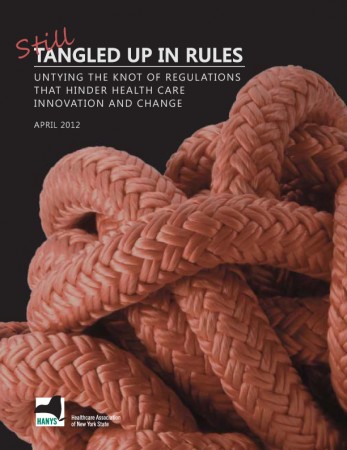Rules block reform in New York health care
A leading advocate for New York hospitals says the state”™s long practice of adding its own regulatory standards for health care to federal standards has been costly to health care providers and has not improved the quality of care for New Yorkers when compared with the rest of the nation.
The state”™s health care rules, says the Healthcare Association of New York State, “have simply not kept up with the times.” In this time of health care reform at the state and federal level, those regulations form “a barrier to progress” and do not allow the flexibility and innovation that are needed.
That criticism is included in a recent HANYS report, “Still Tangled Up in Rules,” that recommends changes to specific state regulations that hinder health care innovation and change. The report was released in tandem with HANYS”™ annual workforce survey report on nursing and allied health care professionals. Those health care professions are expected to be in greater demand as the nation”™s realigned health care delivery system takes shape.
HANYS officials said the state Health Department”™s certificate of need (CON) program for expansion and construction projects by hospitals and other health care facilities is the chief obstacle to reconfiguring the delivery system in New York.
Delays in the CON application process, which is administered by the Health Department”™s Public Health and Health Planning Council, result in higher construction costs and delay patients”™ access to modern treatments and facilities, the report noted. “The CON process needs to incentivize rather than block reconfiguration and should be designed to improve timely access to the most current and effective treatments,” HANYS said.
HANYS recommends that the certificate of need be eliminated for services by licensed health care providers other than hospitals. That would ease project requirements and costs to build primary-care facilities for private physicians looking to partner with hospitals, for example.
Those hospital-doctor alliances are expected to increase in the new health care system. In May, Westmed Practice Partners, a startup division of the 230-physician Westmed Medical Group, announced its partnership with Mount Sinai Medical Center. The New York City hospital will outsource the operation of a 75,000-square-foot outpatient medical office in Brooklyn Heights to Westmed. Dr. Simeon Schwartz, Westmed”™s founder and president, called the Mount Sinai partnership “an industry-transformative event” in health care.
The state Health Department, said HANYS, should be limited to 60 days to respond to any CON applicant proposing to reconfigure a facility or create or expand outpatient service. The proposal should be automatically approved if the state fails to meet the 60-day deadline.
HANYS said outdated hospital workforce requirements and limitations on what health care professionals can perform within their licensed field ”“ called scope of practice ”“ “restrict flexibility at a time when flexibility should be increased.” That view potentially could put HANYS in conflict with state and county medical societies, which have vigilantly sought to protect health services long performed by physicians from being done by nurses and other professionals.
The hospitals advocate also wants the state to give registered nurses expanded authority to implement standing orders, or standard treatment procedures that do not require a doctor”™s written medical order for a specific patient. “Outdated scope of practice restrictions in New York state are not consistent with current national standards and impede delivery system efficiency,” HANYS said.
To increase flexibility, HANYS recommended that registered nurses in New York no longer be required to have one year of clinical experience before working in an emergency department. State regulations prohibit what has become the national standard in nursing, a mentoring program for new emergency room nurses to provide training and experience.
HANYS officials said the state should stop requiring doctors who provide telemedicine consultations remotely to have the patient”™s health assessed by the hospital where the patient is located. New York already has eliminated the hospital assessment for physicians consulting from areas outside the state.
For hospital-employed physicians, HANYS recommended the state allow them to make paid house calls to treat patients in their homes or in nursing homes. Current state regulations prohibit that. Allowing house calls “would better serve the patients they see and would reduce costs,” HANYS said.
For pharmacists and several other licensed professions, New York does not allow non-U.S. citizens to practice in the state. That should be changed to allow professionals with non-immigrant visas or other legal credentials to practice here and “to create the largest pool of qualified professionals possible,” HANYS said.
To eliminate duplicate and nonessential medical reporting requirements, HANYS recommended the governor”™s office establish a work group of Health Department and industry representatives to report within six months on a plan to reform the reporting system and share information among state databases.
Many of the state”™s regulations date to the late 1980s and have never been updated, HANYS officials said, “though the health care industry has evolved dramatically during that period. New York state rules have simply not kept up with the times.”
